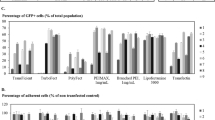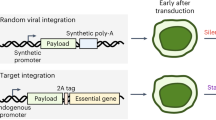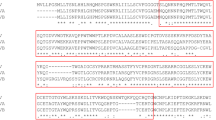Abstract
Lentiviruses are becoming progressively more popular as gene therapy vectors due to their ability to integrate into quiescent cells and recent clinical trial successes. Directing these vectors to specific cell types and limiting off-target transduction in vivo remains a challenge. Replacing the viral envelope proteins responsible for cellular binding, or pseudotyping, remains a common method to improve lentiviral targeting. Here, we describe the development of a high titer, third generation lentiviral vector pseudotyped with Nipah virus fusion protein (NiV-F) and attachment protein (NiV-G). Critical to high titers was truncation of the cytoplasmic domains of both NiV-F and NiV-G. As known targets of wild-type Nipah virus, primary endothelial cells are shown to be effectively transduced by the Nipah pseudotype. In contrast, human CD34+ hematopoietic progenitors were not significantly transduced. Additionally, the Nipah pseudotype has increased stability in human serum compared with vesicular stomatitis virus pseudotyped lentivirus. These findings suggest that the use of Nipah virus envelope proteins in third generation lentiviral vectors would be a valuable tool for gene delivery targeted to endothelial cells.
This is a preview of subscription content, access via your institution
Access options
Subscribe to this journal
Receive 6 print issues and online access
$259.00 per year
only $43.17 per issue
Buy this article
- Purchase on SpringerLink
- Instant access to full article PDF
Prices may be subject to local taxes which are calculated during checkout









Similar content being viewed by others
References
Sheridan C . Gene therapy finds its niche. Nat Biotechnol 2011; 29: 121–128.
Zufferey R, Dull T, Mandel RJ, Bukovsky A, Quiroz D, Naldini L et al. Self-inactivating lentivirus vector for safe and efficient in vivo gene delivery. J Virol 1998; 72: 9873–9880.
Ramezani A, Hawley TS, Hawley RG . Combinatorial incorporation of enhancer-blocking components of the chicken beta-globin 5′HS4 and human T-cell receptor alpha/delta BEAD-1 insulators in self-inactivating retroviral vectors reduces their genotoxic potential. Stem Cells 2008; 26: 3257–3266.
Lewinski MK, Yamashita M, Emerman M, Ciuffi A, Marshall H, Crawford G et al. Retroviral DNA integration: viral and cellular determinants of target-site selection. PLoS Pathog 2006; 2: e60.
Cavazzana-Calvo M, Payen E, Negre O, Wang G, Hehir K, Fusil F et al. Transfusion independence and HMGA2 activation after gene therapy of human beta-thalassaemia. Nature 2010; 467: 318–322.
Levine BL, Humeau LM, Boyer J, MacGregor RR, Rebello T, Lu X et al. Gene transfer in humans using a conditionally replicating lentiviral vector. Proc Natl Acad Sci USA 2006; 103: 17372–17377.
Montini E, Cesana D, Schmidt M, Sanvito F, Bartholomae CC, Ranzani M et al. The genotoxic potential of retroviral vectors is strongly modulated by vector design and integration site selection in a mouse model of HSC gene therapy. J Clin Invest 2009; 119: 964–975.
Bischof D, Cornetta K . Flexibility in cell targeting by pseudotyping lentiviral vectors. Methods Mol Biol 2010; 614: 53–68.
Rossetti M, Gregori S, Hauben E, Brown BD, Sergi LS, Naldini L et al. HIV-1-derived lentiviral vectors directly activate plasmacytoid dendritic cells, which in turn induce the maturation of myeloid dendritic cells. Hum Gene Ther 2011; 22: 177–188.
Frecha C, Costa C, Levy C, Negre D, Russell SJ, Maisner A et al. Efficient and stable transduction of resting B lymphocytes and primary chronic lymphocyte leukemia cells using measles virus gp displaying lentiviral vectors. Blood 2009; 114: 3173–3180.
Funke S, Maisner A, Muhlebach MD, Koehl U, Grez M, Cattaneo R et al. Targeted cell entry of lentiviral vectors. Mol Ther 2008; 16: 1427–1436.
Kobayashi M, Iida A, Ueda Y, Hasegawa M . Pseudotyped lentivirus vectors derived from simian immunodeficiency virus SIVagm with envelope glycoproteins from paramyxovirus. J Virol 2003; 77: 2607–2614.
Enkirch T, Kneissl S, Hoyler B, Ungerechts G, Stremmel W, Buchholz CJ et al. Targeted lentiviral vectors pseudotyped with the Tupaia paramyxovirus glycoproteins. Gene therapy 2013; 20: 16–23.
Khetawat D, Broder CC . A functional henipavirus envelope glycoprotein pseudotyped lentivirus assay system. Virol J 2010; 7: 312.
Eaton BT, Broder CC, Middleton D, Wang LF . Hendra and Nipah viruses: different and dangerous. Nat Rev Microbiol 2006; 4: 23–35.
Luby SP, Gurley ES, Hossain MJ . Transmission of human infection with Nipah virus. Clin Infect Dis 2009; 49: 1743–1748.
Bonaparte MI, Dimitrov AS, Bossart KN, Crameri G, Mungall BA, Bishop KA et al. Ephrin-B2 ligand is a functional receptor for Hendra virus and Nipah virus. Proc Natl Acad Sci USA 2005; 102: 10652–10657.
Negrete OA, Levroney EL, Aguilar HC, Bertolotti-Ciarlet A, Nazarian R, Tajyar S et al. EphrinB2 is the entry receptor for Nipah virus, an emergent deadly paramyxovirus. Nature 2005; 436: 401–405.
Negrete OA, Wolf MC, Aguilar HC, Enterlein S, Wang W, Muhlberger E et al. Two key residues in ephrinB3 are critical for its use as an alternative receptor for Nipah virus. PLoS Pathog 2006; 2: e7.
Shin D, Garcia-Cardena G, Hayashi S, Gerety S, Asahara T, Stavrakis G et al. Expression of ephrinB2 identifies a stable genetic difference between arterial and venous vascular smooth muscle as well as endothelial cells, and marks subsets of microvessels at sites of adult neovascularization. Dev Biol 2001; 230: 139–150.
Foo SS, Turner CJ, Adams S, Compagni A, Aubyn D, Kogata N et al. Ephrin-B2 controls cell motility and adhesion during blood-vessel-wall assembly. Cell 2006; 124: 161–173.
Ishikawa K, Tilemann L, Fish K, Hajjar RJ . Gene delivery methods in cardiac gene therapy. J Gene Med 2011; 13: 566–572.
Du L, Dronadula N, Tanaka S, Dichek DA . Helper-dependent adenoviral vector achieves prolonged, stable expression of interleukin-10 in rabbit carotid arteries but does not limit early atherogenesis. Hum Gene Ther 2011; 22: 959–968.
Song YK, Liu F, Liu D . Enhanced gene expression in mouse lung by prolonging the retention time of intravenously injected plasmid DNA. Gene Ther 1998; 5: 1531–1537.
Djokovic D, Trindade A, Gigante J, Badenes M, Silva L, Liu R et al. Combination of Dll4/Notch and Ephrin-B2/EphB4 targeted therapy is highly effective in disrupting tumor angiogenesis. BMC cancer 2010; 10: 641.
Abengozar MA, de Frutos S, Ferreiro S, Soriano J, Perez-Martinez M, Olmeda D et al. Blocking ephrinB2 with highly specific antibodies inhibits angiogenesis, lymphangiogenesis, and tumor growth. Blood 2012; 119: 4565–4576.
De Palma M, Venneri MA, Naldini L . In vivo targeting of tumor endothelial cells by systemic delivery of lentiviral vectors. Hum Gene Ther 2003; 14: 1193–1206.
Hohne M, Thaler S, Dudda JC, Groner B, Schnierle BS . Truncation of the human immunodeficiency virus-type-2 envelope glycoprotein allows efficient pseudotyping of murine leukemia virus retroviral vector particles. Virology 1999; 261: 70–78.
Indraccolo S, Minuzzo S, Feroli F, Mammano F, Calderazzo F, Chieco-Bianchi L et al. Pseudotyping of Moloney leukemia virus-based retroviral vectors with simian immunodeficiency virus envelope leads to targeted infection of human CD4+ lymphoid cells. Gene Ther 1998; 5: 209–217.
Weise C, Erbar S, Lamp B, Vogt C, Diederich S, Maisner A . Tyrosine residues in the cytoplasmic domains affect sorting and fusion activity of the Nipah virus glycoproteins in polarized epithelial cells. J Virol 2010; 84: 7634–7641.
Diederich S, Moll M, Klenk HD, Maisner A . The nipah virus fusion protein is cleaved within the endosomal compartment. J Biol Chem 2005; 280: 29899–29903.
Diederich S, Sauerhering L, Weis M, Altmeppen H, Schaschke N, Reinheckel T et al. Activation of the Nipah virus fusion protein in MDCK cells is mediated by cathepsin B within the endosomal-recycling compartment. J Virol 2012; 86: 3736–3745.
Pager CT, Dutch RE . Cathepsin L is involved in proteolytic processing of the Hendra virus fusion protein. J Virol 2005; 79: 12714–12720.
Aguilar HC, Matreyek KA, Choi DY, Filone CM, Young S, Lee B . Polybasic KKR motif in the cytoplasmic tail of Nipah virus fusion protein modulates membrane fusion by inside-out signaling. J Virol 2007; 81: 4520–4532.
Pernet O, Pohl C, Ainouze M, Kweder H, Buckland R . Nipah virus entry can occur by macropinocytosis. Virology 2009; 395: 298–311.
Vogt C, Eickmann M, Diederich S, Moll M, Maisner A . Endocytosis of the Nipah virus glycoproteins. J Virol 2005; 79: 3865–3872.
Mathieu C, Guillaume V, Sabine A, Ong KC, Wong KT, Legras-Lachuer C et al. Lethal Nipah virus infection induces rapid overexpression of CXCL10. PLoS One 2012; 7: e32157.
Erbar S, Diederich S, Maisner A . Selective receptor expression restricts Nipah virus infection of endothelial cells. Virol J 2008; 5: 142.
Adams RH, Wilkinson GA, Weiss C, Diella F, Gale NW, Deutsch U et al. Roles of ephrinB ligands and EphB receptors in cardiovascular development: demarcation of arterial/venous domains, vascular morphogenesis, and sprouting angiogenesis. Genes Dev 1999; 13: 295–306.
Wang HU, Chen ZF, Anderson DJ . Molecular distinction and angiogenic interaction between embryonic arteries and veins revealed by ephrin-B2 and its receptor Eph-B4. Cell 1998; 93: 741–753.
Mathieu C, Pohl C, Szecsi J, Trajkovic-Bodennec S, Devergnas S, Raoul H et al. Nipah virus uses leukocytes for efficient dissemination within a host. J Virol 2011; 85: 7863–7871.
Ailles L, Schmidt M, Santoni de Sio FR, Glimm H, Cavalieri S, Bruno S et al. Molecular evidence of lentiviral vector-mediated gene transfer into human self-renewing, multi-potent, long-term NOD/SCID repopulating hematopoietic cells. Mol Ther 2002; 6: 615–626.
Millington M, Arndt A, Boyd M, Applegate T, Shen S . Towards a clinically relevant lentiviral transduction protocol for primary human CD34 hematopoietic stem/progenitor cells. PLoS One 2009; 4: e6461.
Sandrin V . Cosset FL. Intracellular versus cell surface assembly of retroviral pseudotypes is determined by the cellular localization of the viral glycoprotein, its capacity to interact with Gag, and the expression of the Nef protein. J Biol Chem 2006; 281: 528–542.
Pelchen-Matthews A, Kramer B, Marsh M . Infectious HIV-1 assembles in late endosomes in primary macrophages. J Cell Biol 2003; 162: 443–455.
Williamson MM, Torres-Velez FJ . Henipavirus: a review of laboratory animal pathology. Vet Pathol 2010; 47: 871–880.
Maisner A, Neufeld J, Weingartl H . Organ- and endotheliotropism of Nipah virus infections in vivo and in vitro. Thromb Haemost 2009; 102: 1014–1023.
Ryan-Poirier KA, Kawaoka Y . Alpha 2-macroglobulin is the major neutralizing inhibitor of influenza A virus in pig serum. Virology 1993; 193: 974–976.
Cwach KT, Sandbulte HR, Klonoski JM, Huber VC . Contribution of murine innate serum inhibitors toward interference within influenza virus immune assays. Influenza Other Respi Viruses 2012; 6: 127–135.
Kong D, Wen Z, Su H, Ge J, Chen W, Wang X et al. Newcastle disease virus-vectored Nipah encephalitis vaccines induce B and T cell responses in mice and long-lasting neutralizing antibodies in pigs. Virology 2012; 432: 327–335.
Guillaume V, Contamin H, Loth P, Georges-Courbot MC, Lefeuvre A, Marianneau P et al. Nipah virus: vaccination and passive protection studies in a hamster model. J Virol 2004; 78: 834–840.
Weingartl HM, Berhane Y, Caswell JL, Loosmore S, Audonnet JC, Roth JA et al. Recombinant nipah virus vaccines protect pigs against challenge. J Virol 2006; 80: 7929–7938.
Chan YP, Lu M, Dutta S, Yan L, Barr J, Flora M et al. Biochemical, conformational, and immunogenic analysis of soluble trimeric forms of henipavirus fusion glycoproteins. J Virol 2012; 86: 11457–11471.
Breckpot K, Escors D, Arce F, Lopes L, Karwacz K, Van Lint S et al. HIV-1 lentiviral vector immunogenicity is mediated by Toll-like receptor 3 (TLR3) and TLR7. J Virol 2010; 84: 5627–5636.
Palomares K, Vigant F, Van Handel B, Pernet O, Chikere K, Hong P et al. Nipah virus envelope-pseudotyped lentiviruses efficiently target ephrinB2-positive stem cell populations in vitro and bypass the liver sink when administered in vivo. J Virol 2013; 87: 2094–2108.
Nakada M, Anderson EM, Demuth T, Nakada S, Reavie LB, Drake KL et al. The phosphorylation of ephrin-B2 ligand promotes glioma cell migration and invasion. Int J Cancer 2010; 126: 1155–1165.
Alam SM, Fujimoto J, Jahan I, Sato E, Tamaya T . Coexpression of EphB4 and ephrinB2 in tumor advancement of uterine cervical cancers. Gynecol Oncol 2009; 114: 84–88.
Coil DA, Miller AD . Phosphatidylserine is not the cell surface receptor for vesicular stomatitis virus. J Virol 2004; 78: 10920–10926.
Negrete OA, Chu D, Aguilar HC, Lee B . Single amino acid changes in the Nipah and Hendra virus attachment glycoproteins distinguish ephrinB2 from ephrinB3 usage. J Virol 2007; 81: 10804–10814.
Ingram DA, Mead LE, Tanaka H, Meade V, Fenoglio A, Mortell K et al. Identification of a novel hierarchy of endothelial progenitor cells using human peripheral and umbilical cord blood. Blood 2004; 104: 2752–2760.
Tamin A, Harcourt BH, Ksiazek TG, Rollin PE, Bellini WJ, Rota PA . Functional properties of the fusion and attachment glycoproteins of Nipah virus. Virology 2002; 296: 190–200.
Marr RA, Guan H, Rockenstein E, Kindy M, Gage FH, Verma I et al. Neprilysin regulates amyloid Beta peptide levels. J Mol Neurosci 2004; 22: 5–11.
Kahl CA, Marsh J, Fyffe J, Sanders DA, Cornetta K . Human immunodeficiency virus type 1-derived lentivirus vectors pseudotyped with envelope glycoproteins derived from Ross River virus and Semliki Forest virus. J virol 2004; 78: 1421–1430.
Acknowledgements
We thank Dr Paul Rota (Center for Disease Control, Atlanta, GA) for plasmids containing the complementary DNA for NiV-G and NiV-F and Dr Christopher Broder (Uniformed Services University, Bethesda, MD) for the NiV-G and NiV-F antibodies. We also thank the National Gene Vector Biorepository (Indianapolis, IN) for the lentiviral production plasmids. HUVECs were a kind gift from the laboratory of Dr Merv Yoder (Indianapolis, IN). This work was supported by the National Institutes of Health grant P30HL101337-02.
Author information
Authors and Affiliations
Corresponding author
Ethics declarations
Competing interests
The authors declare no conflict of interest.
Rights and permissions
About this article
Cite this article
Witting, S., Vallanda, P. & Gamble, A. Characterization of a third generation lentiviral vector pseudotyped with Nipah virus envelope proteins for endothelial cell transduction. Gene Ther 20, 997–1005 (2013). https://doi.org/10.1038/gt.2013.23
Received:
Revised:
Accepted:
Published:
Issue Date:
DOI: https://doi.org/10.1038/gt.2013.23
Keywords
This article is cited by
-
AZGP1 deficiency promotes angiogenesis in prostate cancer
Journal of Translational Medicine (2024)
-
TRAP1 inhibits MIC60 ubiquitination to mitigate the injury of cardiomyocytes and protect mitochondria in extracellular acidosis
Cell Death Discovery (2021)
-
A simple strategy for retargeting lentiviral vectors to desired cell types via a disulfide-bond-forming protein-peptide pair
Scientific Reports (2018)
-
CAR-T cells: the long and winding road to solid tumors
Cell Death & Disease (2018)
-
Actin filament dynamics and endothelial cell junctions: the Ying and Yang between stabilization and motion
Cell and Tissue Research (2014)



